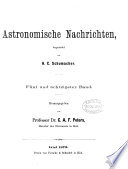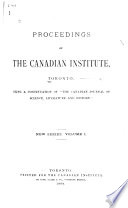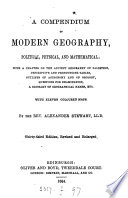 | 1875 - 916 pages
...equal times; and The squares of the times of revolution <>f the different bodies are to each other in the same proportion as the cubes of their mean distances from the sun. These three laws, which were discovered by Kepler, **У be regarded as the embodiment of the theory... | |
 | Henry Grattan Guinness - 1878 - 736 pages
...modern astronomy — is that " the squares of the periodic times of any two planets, are to each other in the same proportion as the cubes of their mean distances from the sun." This law, discovered after seventeen years of patient toil, by the ardentjand pious astronomer, who... | |
 | John Nelson Stockwell - 1881 - 428 pages
...equal areas in equa1 times; and THIRD. — The squares of the times of revo1ution of the different planets are in the same proportion as the cubes of their mean distances from the sun. These are KEPLER'S three laws of the planetary motions ; they were discovered early in the seventeenth... | |
 | George Biddell Airy - 1881 - 310 pages
...planets going round the sun, we shall find that the squares of the times of revolution of the different planets are in the same proportion as the cubes of their mean distances from the eun. That was a most important thing to establish. The second of Kepler's laws was this. In Figure... | |
 | Alexander Mackay - 1881 - 714 pages
...planet may be moving. 8. The squares of the times of revolution of any two planets are to each other in the same proportion as the cubes of their mean distances from the sun. Finally, the world-renowned Newton (horn at Woolsthorpe in Lincolnshire, in 1 643) placed the keystone... | |
 | Canadian Institute - 1884 - 880 pages
...Copernicus was a contemporary of Luther, dying just three years before him, and, though he lived and died in the old faith, was, in his own way, as much...half of the seventeenth century Newton appears on tho scene to furnish a mathematical explanation of the motions of the heavenly bodies. About 158 1... | |
 | Canadian Institute (1849-1914) - 1884 - 478 pages
...revolt against authority. Though he seems to have satisfied himself of the truth of his viewsearly in the century, he did not promulgate them till about...explanation of the motions of the heavenly bodies. About 158 1 the laws of the equilibrium of fluids, which had been known to Archimedes, were rediscovered by Stevinus.... | |
 | Alexander Stewart - 1884 - 586 pages
...in equal times. B 2. The orbits of the planets are ELLIPSES, having the son in one of the foci. 3. The squares of the periodic times of the planets are...proportion as the cubes of their mean distances from the •on. The railing vector of a planet is an imaginary straight line from the sun to the planet, supposed... | |
 | 1884 - 924 pages
...259, gives it in these words: " The squares of the periodic times of any two planets are to each other in the same proportion as the cubes of their mean distances from the Sun." On November loth we received a letter from Prof. HS Pritchett, St. Louis, Mo,, which said, — "As... | |
 | William Thynne Lynn - 1884 - 106 pages
...throughout. That law is that the squares of the periodic times of any two planets moving round the Sun are in the same proportion as the cubes of their mean distances from him. Planet. Symbol. Period in Days. Comparative Mean Distance from the Sun. Eccentricity of Orbit.... | |
| |